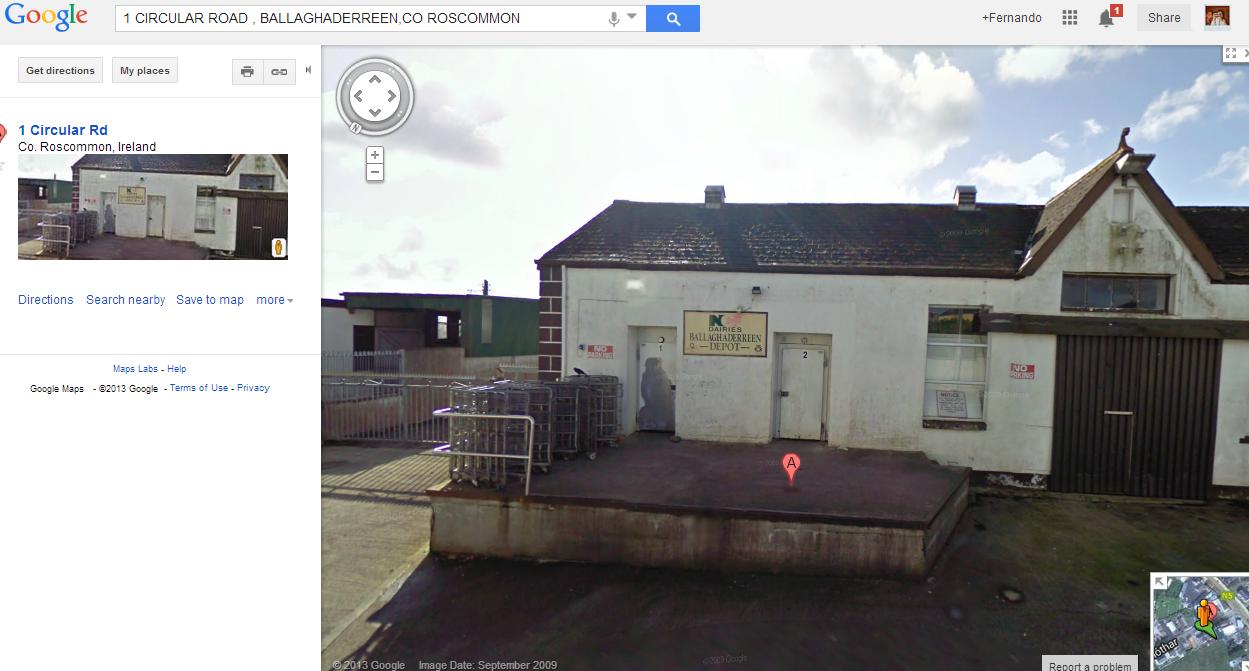Brian Griffin, the fan-favorite talking dog from Fox’s Family Guy, had just been brutally killed. Fans were stunned. For 12 seasons, Brian had been a highbrow, martini-slingin’ alternative to the slapstick humor of Peter Griffin, the show’s main character.
The following Monday, thousands of grieving fans flocked to the countdown site briansannouncement.com, a mysterious site that promised, as its URL implied, “a special announcement from Brian.” It seemed to check out. It looked official, had associated social media accounts, and referenced Quahog, the setting of Family Guy. After all, show creator Seth MacFarlane had already proven with The Cleveland Show that he’s willing to spin off major characters into a standalone series.
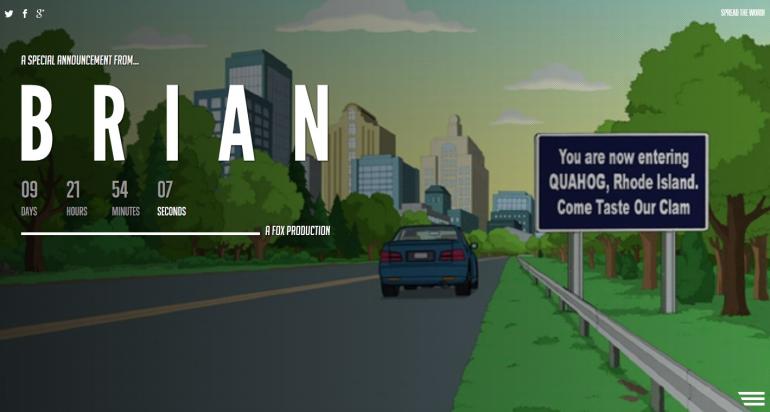
“Brian’s Announcement ” was an immediate hit, an unexpected lifeline that hit at just the right moment. It was reported on by Time, Gawker, CNN, and more.
But there was no announcement. The site was an opportunistic hoax.
“The producers have confirmed that the ‘special announcement from Brian’ website is a hoax and was not created by anyone connected to the show, studio or network,” the network said in a statement provided to TVLine on the morning of Nov. 26, just two days after the Family Guy episode aired.
By that afternoon, the countdown on briansannouncement.com had ended. The site redirected to another one called #savebrian. At a quick glance, #savebrian was nothing remarkable. With its social media buttons and a petition to MacFarlane to “keep Brian alive,” #savebrian was exactly what you’d expect from a marketing company desperate to keep a campaign relevant.
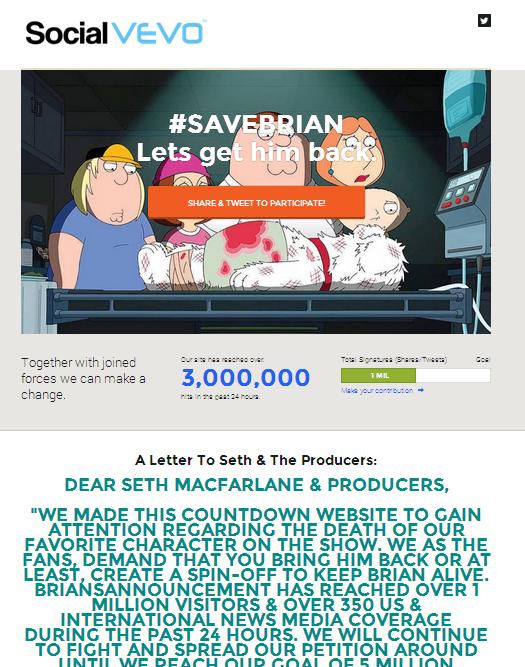
But SocialVEVO, the group behind Brian’s Announcement, isn’t your average marketing firm. By ripping off the trademarks and images of some of the world’s most recognizable products and organizations, SocialVEVO has duped millions of people into doing more than just liking something on Facebook. It’s all about making money.
And this is how they do it.
•••
The video languished on my YouTube channel for more than two years. It didn’t have a catchy title or a cute cat jumping into cardboard boxes. It featured former Daily Dot editor Owen Thomas getting his dance on at our first official all-company meeting. Before Nov. 21, 2013, it had 60 views.
Then someone claiming to work for SocialVEVO used it to show me what the group is capable of.
“I will demonstrate for you,” he told me using Skype’s chat feature. “Exclusive deal.”
He told me to add “S.V” to the title of my video, sit back, and watch. By that night, the video had 41,000 views. A day later, it was at 568,000.
What he had done was manipulate YouTube views through botting, a controversial practice that has dogged the site since at least 2009. It’s also a frighteningly easy thing to do. Last August, Daily Dot contributor Chase Hoffberger purchased half a million views for his otherwise unnotable cinnamon challenge video in online black markets. He paid a mere $500 for the fake views, and it took YouTube five months to notice.
There are various methods of botting, traded on shady Internet forums, but all of them exploit YouTube’s API to inflate view counts. The more views a video gets, the more advertising revenue it pulls in and the better chance it has at generating real buzz, which makes generating thousands of fake views a lucrative business.
And that’s where SocialVEVO comes in. One of its founders, who goes by “Jacob Povolotski” online, is a major player in the YouTube botting game. He first made a name for himself in 2012, when he drove 8 million fraudulent views to a self-produced rap video called “Pickles.” In the video, Povolotski—whose comedy rap name is “Yasha Swag”—sports a mop top haircut and spits utter nonsense atop a headache-inducing beat. The original video has been deleted, but the legend lives on in reposts.
Povolotski’s identity is a like a bad jigsaw puzzle—you can find pieces on sites like LinkedIn, Concrete 5, and Black Hat World (a forum where people trade shady search engine optimization tips), but they don’t come close to forming a complete picture. Someone claiming to work for SocialVEVO told me that “Jacob Povolotski” isn’t even a real name.
This much is certain: Povolotski doesn’t work alone, and with YouTube cracking down on botters like never before, his business model is in disarray.
“‘Pickles’ being botted had hundreds of thousands at [Black Hat World] scrambling,” another alleged SocialVEVO employee told me. He also claimed that when YouTube removed millions of fake views from channels run by major labels like Sony and Universal after the Pickles scandal, the black market YouTube economy took a huge hit.
Simply providing inflated view counts wasn’t going to cut it anymore. What Povolotski and his team needed, they claimed, was a new business model.
They found their answer in viral marketing campaigns. SocialVEVO would create fake campaigns, pretending to represent major brands. For maximum impact, they’d pick targets that were grabbing headlines. By the time the Internet caught on to its hoaxes and the targeted companies took action, SocialVEVO would already have its views—and its money.
Their first victim was NASA.
•••
In late September, more than 800,000 federal employees were temporarily out of work in a partisan dispute over the Affordable Care Act. The furloughed employees included 17,400 NASA staffers, leaving just a skeleton crew to monitor crucial operations like the International Space Station. It was the first shutdown of the American government since 1995.
At 4:16pm on Oct. 1, rememberthe13th.com was registered on Namecheap.com. This was just a few hours after NASA had announced that, due to the government shutdown, all public activities and events were cancelled.
That evening, Remember the 13th was fully operational. The site featured a rocketship, a flurry of social media buttons, and a countdown to Nov. 13, when it promised to reveal “the biggest discovery that will shake the Earth.” In the top left hand side of the page was the official NASA logo.

“The website is currently being tweeted 100 times per minute and has over 50k facebook shares,” read a message I received Oct. 5 from SocialVEVO. “It has took over worldwide forums and social media. Worldwide news media reports the announcement could be alien life.”
But the site got the Internet wondering: If NASA was shut down, how could it put together such a groundbreaking scientific revelation?
It couldn’t, of course.
Reddit’s r/conspiracy forum and 4chan’s paranormal imageboard, /x/, were the first to raise the alarm about SocialVEVO’s hoax.
“Can I just say how devious it is of them to pretend to be NASA right about now?” redditor adrianbrony commented. “[T]hat means that the ACTUAL NASA won’t be able to step in and debunk this because they are currently defunded until the shutdown ends. So they have to just sit there while this idiot makes a liar and a fool out of them in the public eye and there’s nothing they can do about it.”
By Oct. 4, media organizations had gotten wise, too.
“Clearly, this is really just some sort of viral marketing attempt (which, just as clearly, is working well),” reported Phil “Bad Astronomer” Plait at Slate.
With no other webs left to spin, SocialVEVO made its grand reveal. It was a YouTube video for “Purple Ninja, “ by an unknown singer named Beeki Vendi. The man in the video was Povolotski, easily recognizable from “Pickles.” The original video has been deleted from YouTube, but it’s survived on at Jukebox.es (for now).
“Purple Ninja was a successful ‘test,’” a source claiming to be an ex-SocialVEVO employee told me. “Boosting YouTube views and Facebook likes is pure psychology and will make a trend popular and interesting. Everyone follows the buzz. This is the only way these campaigns are successful.”
…
The model works because SocialVEVO moves too quickly and creates too much confusion to be caught by the companies it pretends to represent. By the time Fox debunked “Brian’s Announcement,” the site had already accomplished its mission, attracting thousands of distraught Family Guy fans.
It’s not clear how exactly the company profits in the short term. It’s as if SocialVEVO’s sprinting towards a long con, hoping to figure it out by the time it reaches the finish line.
Even the name SocialVEVO is likely temporary.
“[SocialVEVO] has no affiliation with VEVO,” a VEVO representative told me. “Additionally, we are in contact with the site to enforce our trademark and ensure they discontinue using the VEVO name.”
It wouldn’t be the first time Povolotski and company have changed names, according to an alleged former employee I spoke with.
“They’re the same people who have made viral videos happen since 2008,” he told me. “They’ve just been switching names and moving each time someone exposes them to keep open.”
Through all of our conversations, SocialVEVO employees gave me enough information to promote their next campaign, but never enough to pin down their identities. Even the ex-employee who told me he wanted to see SocialVEVO exposed later admitted he’d been behind the Brian’s Announcement campaign, which took place after he’d supposedly left the company.
All of the SocialVEVO associates I chatted with on Skype could be the same person. Any of them could be Povolotski—if that’s even his real name. The genius of SocialVEVO is that it’s impossible to tell.
Povolotski is still a phantom with a growing trail of breadcrumbs that lead nowhere. A SocialVEVO-related email address pointed me to the site icanhazviews.com (which currently redirects to socialvevo.com). The site’s whois record lists Povolotski’s name and an address in Ballaghaderreen, Ireland. If the Google Maps image of that address is current, the building is actually a dairy depot.
Another dead end.
As of Thursday night, SocialVEVO’s site is still up and accepting new customers. It’s been a week since VEVO claims to have contacted the company with a warning about trademark infringement.
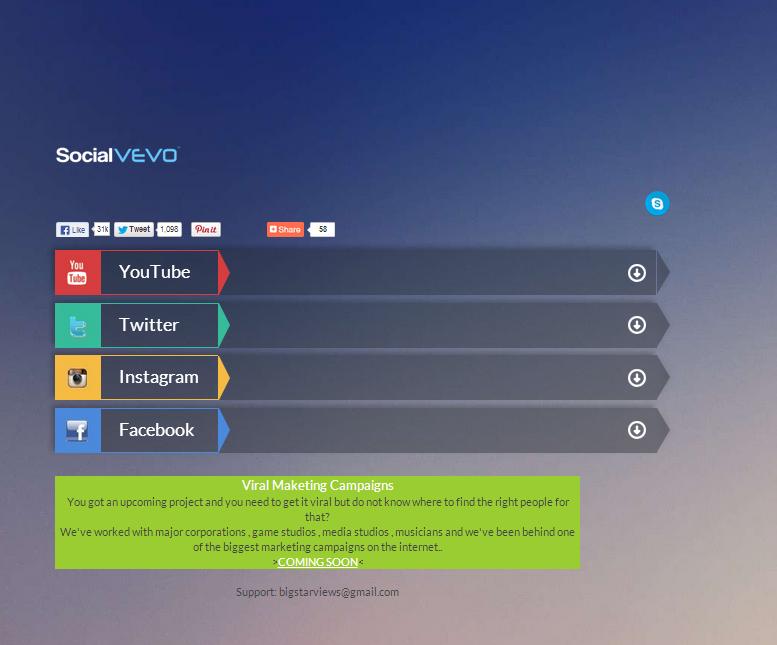
The next campaign SocialVEVO had planned was something called Facebook Revolution. It was another countdown site—pretending to be Facebook, this time—that promised an announcement that would change music forever.
The countdown was due to end Thursday, and the folks at SocialVEVO said they wanted me to know about it before other media organizations latched on.
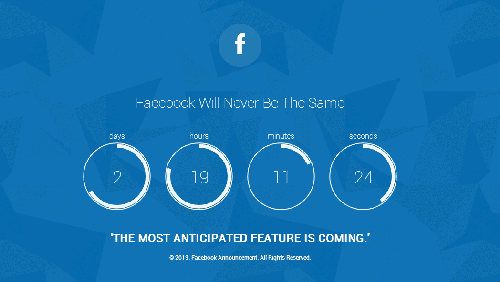
Facebook Revolution never happened. The site has been taken down and replaced with this message: “Hi it feels so lonely here, Nothing to see here.”
It’s anybody’s guess what SocialVEVO’s next hoax site will be. You won’t see it coming until you’ve already clicked.
Update: YouTube has taken down the video SocialVEVO botted for me. The company stated that I violated TOU #4 Section H. That section forbids using any sort of automation to “send more request messages to the YouTube servers in a given period of time than a human can reasonably produce.” Also, as of Dec. 9 evening, SocialVEVO had rebranded itself as Swenzy.
Illustration by Jason Reed


